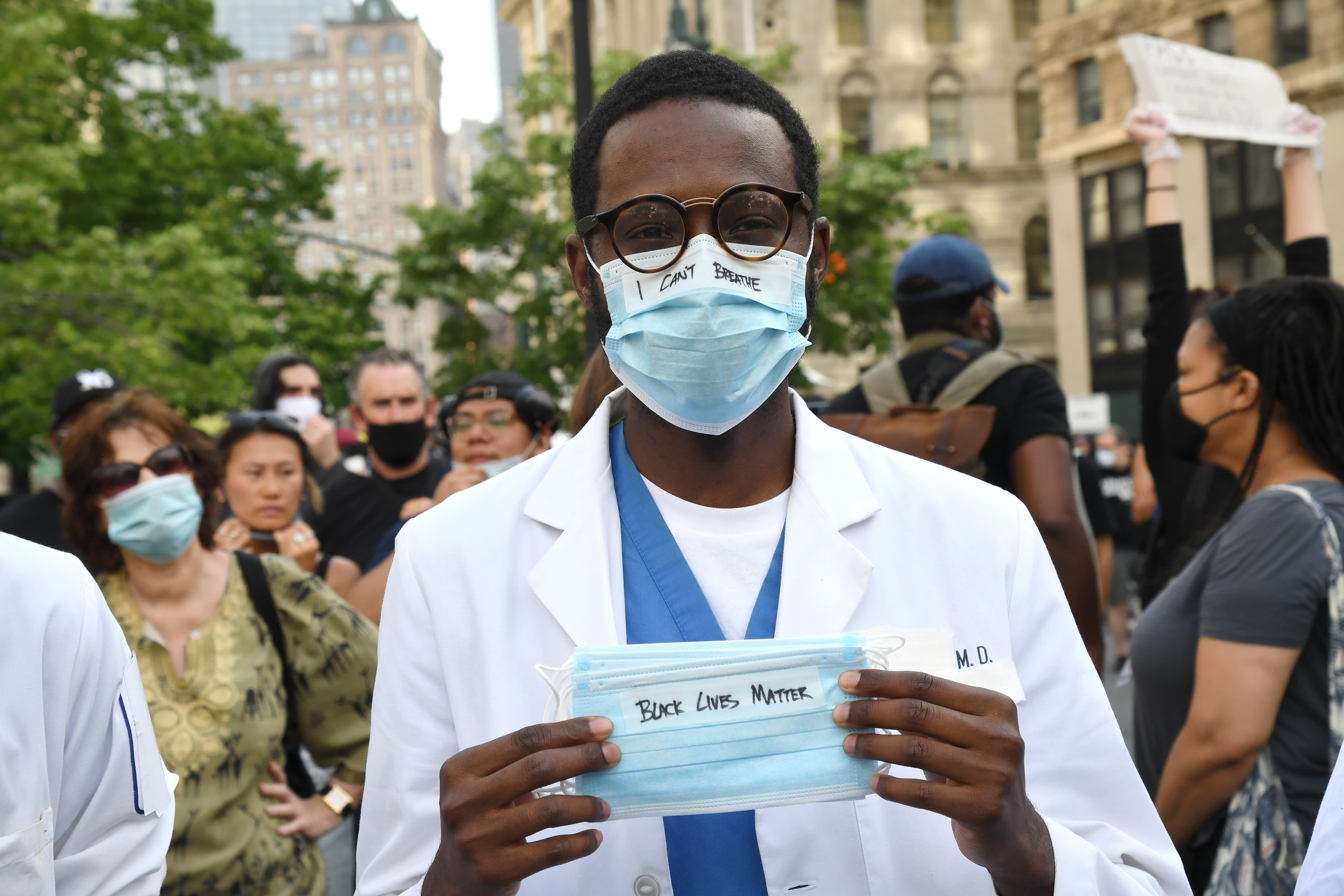A doctor holds up a mask that reads “Black Lives Matter” during a rally against the killing of George Floyd at Foley Square on May 29, 2020 in New York City. Demonstrations are being held across the US after George Floyd died in police custody on May 25.
Kevin Mazur | Getty Images
As people across the United States protest the death of George Floyd at the hands of Minneapolis police, infectious disease experts and doctors fear the large gatherings will spur more Covid-19 infections and make a second wave of the coronavirus in the fall much worse.
“It is difficult to imagine that we will not see a spike in Covid-19 transmission due to the protests,” said Ryan Demmer, an associate professor of epidemiology at the University of Minnesota. “Many days of large, in-person gatherings are powerful forces that can accelerate transmission.”
The virus has hit the U.S. harder than any other country, with more than 1.8 million cases and 105,000 deaths as of Tuesday morning, according to Johns Hopkins University data.
Risk of infection
While cases in hot spots such as New York state have slowed in recent weeks, the “gap between doing OK to being back into a state where we might not have enough ventilators is a narrow gap,” said Dr. Preeti Malani, chief health officer and a professor of medicine and infectious disease at the University of Michigan.
To be sure, infectious disease experts and doctors say it’s difficult to balance the desire to protest injustice against the risk of infection. While protesters cannot eliminate coronavirus risk, they can take steps to decrease the spread or chance of getting it, according to interviews with a dozen epidemiologists, doctors and infectious disease specialists.
Scientists know the coronavirus can spread through respiratory droplets that pass when an infected person coughs, sneezes or even breathes. The droplets of infected fluid can land on nearby surfaces like desks, tables or telephones and infect anyone who touches them.
A study in the New England Journal of Medicine in March found the virus can survive for several hours in aerosols and last days on surfaces such as copper, cardboard, plastic and stainless steel.
Hand sanitizer, hand shakes
Infectious disease experts and doctors recommend using hand sanitizer and avoiding physical contact while greeting people, including shaking hands.
They said protesters should watch what they are touching and avoid touching their eyes, nose and mouth, where the virus can enter the body. They also recommend maintaining at least 6 feet of distance from others when possible.
“You can have a buddy system and stay in smaller groups. Ideally, you want to stay away from big groups,” said Dr. Leana Wen, a professor of health policy and management at the George Washington University. “Don’t hug and kiss. Don’t share drinks. Bring your own water bottle. … Don’t use the same microphone that’s been touched by hundreds of people.”
Protesters should also wear a face covering and eye protection, said Bob Bednarczyk, an epidemiologist at Rollins school of public health at Emory, adding that yelling is another way the virus can be transmitted.
Megaphones
He recommended the use of a megaphone or other voice amplifier. Wen echoed those sentiments, saying, ”you can use signs and a noisemaker instead.”
Some experts are concerned police tactics such as tear gas may cause sneezing and coughing, but Isaac Bogoch, an infectious disease specialist and professor at the University of Toronto, said that may not have much impact on coronavirus spread.
“Maybe you could say it inflames mucus membranes. But I don’t know if it will significantly impact,” he said.
He also said it’s more difficult for the virus to spread outside versus indoors, but cautioned, “in those settings you can’t control the environment around you.”
Imported cases
Yanzhong Huang, a public health researcher at the Council on Foreign Relations and director of the Center for Global Health Studies at Seton Hall University, said the trajectory of the virus and potential for another outbreak to a large extent depends on the level and size of population movements.
Protesters who are not local residents could be a potential problem, said Dr. Katie Passaretti, medical director for infection prevention at Atrium Health in Charlotte, North Carolina.
“I’ve also heard from a number of people about individuals traveling long distances to take part in these protests, and that of course is a concern when it comes to transmission,” Passaretti said.
David Holtgrave, dean at the University of Albany School of Public Health, recommended protesters get regularly tested for Covid-19.
“There are already substantial health disparities among communities of color in terms of Covid-19 impact,” he said. “So, it is important that those already serious disparities are not made even worse.”
